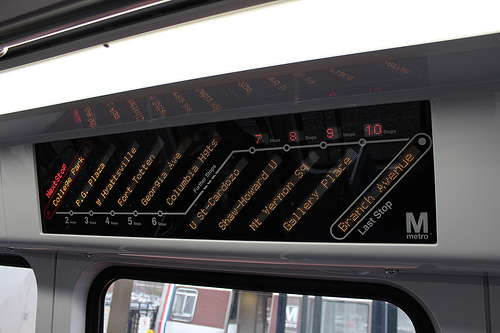Ask GGW: Why don’t the next station displays in the trains work? And will they on the new 7000 series cars?
Reader William points out that the LED displays in many Metro cars don’t work. He asks, since they don’t, do we have reason to think the fancier screens in new 7000 series cars will work?
The 7000 series cars will have many new features including screens that show not only the next stop but several stops along the route.
William writes,
One of the features that the WMATA is touting is the new destination/next stop displays inside the cars that let passengers know where they are and which stops are coming up. This is really great, but I wonder whether operators will actually use it. Whenever I’m riding in a car that has an LED display, it usually only says the color of the line.
I assume the purpose of these screens is to assist passengers to know where they are, similar to the displays in the new cars, but they are rarely utilized. Will operators of the new 7k cars be required to use them? If so, why should operators of 2000-series, 3000-series, 5000-series, and 6000-series cars not be required to do so?
Thanks or your question, William! Actually, the train operator isn’t the reason those LCD strips don’t show the next station. The newer series of cars can tell you about the next stop, but when Metro mixed up the trainsets to put the 1000 series in the middles of the trains, that feature stopped working. The 7000s will not be mixed with older cars (they can’t be) and so the screens ought to work.
Matt Johnson adds: The way the current signs work is that (regardless of the series of car), the operator has to input a destination code, which sets the destination signs on the outside of the train, lines switches along the way, and tells the signs on the interior of the car what line the train is running.
If the train equipment is all of a set that has the equipment (so no 1000s or 4000s), and the train talks to the wayside equipment along the way, the interior signs will display the next station.
The 7000s won’t have the mixing issue, since they’re going to run on their own. I’m not sure how much talking they’re going to have to do with the wayside equipment along the tracks to stay up to date.
However, we won’t know how reliable they’ll be until we see them in action. If there are problems with the wayside equipment, it’s certainly possible they’ll get stuck showing past stations, like the current signs sometimes do. Hopefully, though, Metro has worked out how to solve that problem with the new cars.
Do you have a question?
That’s a great question. And we are sure you have more. Therefore, Greater Greater Washington is going to start a new weekly feature, Ask GGW. We’ve posted questions periodically in the past, but we’re going to try to make this regular. Send your questions to ask@ggwash.org. Each week, we will pick one or two, ask the contributors, and report what they say.
While a lot of reader questions in the past are about Metro, and you are welcome to keep asking those, we’ll try to mix it up with some questions about other transit, other modes of transportation, land use, architecture, economics, education, or whatever else we can help with. So send your questions on over now!


